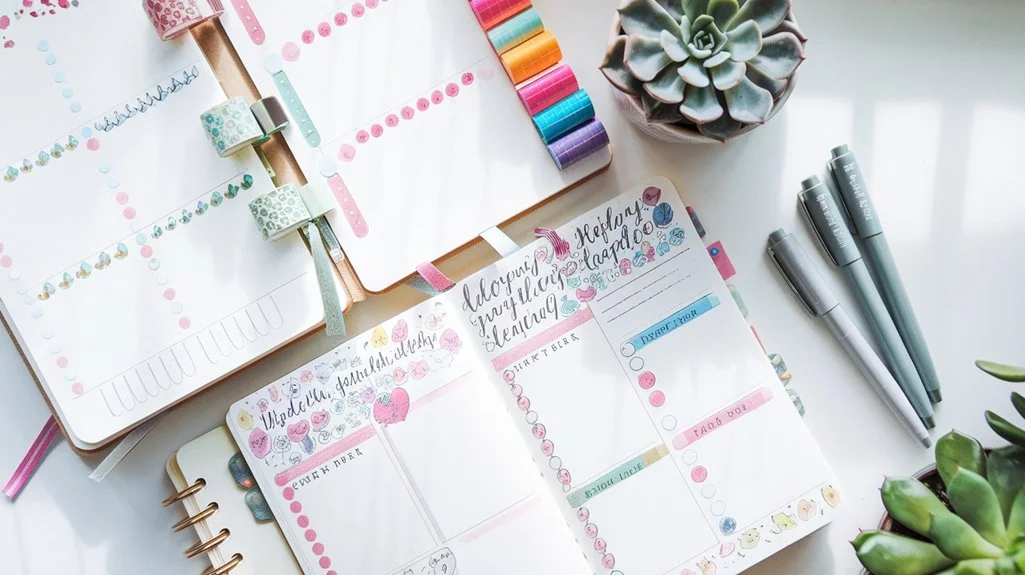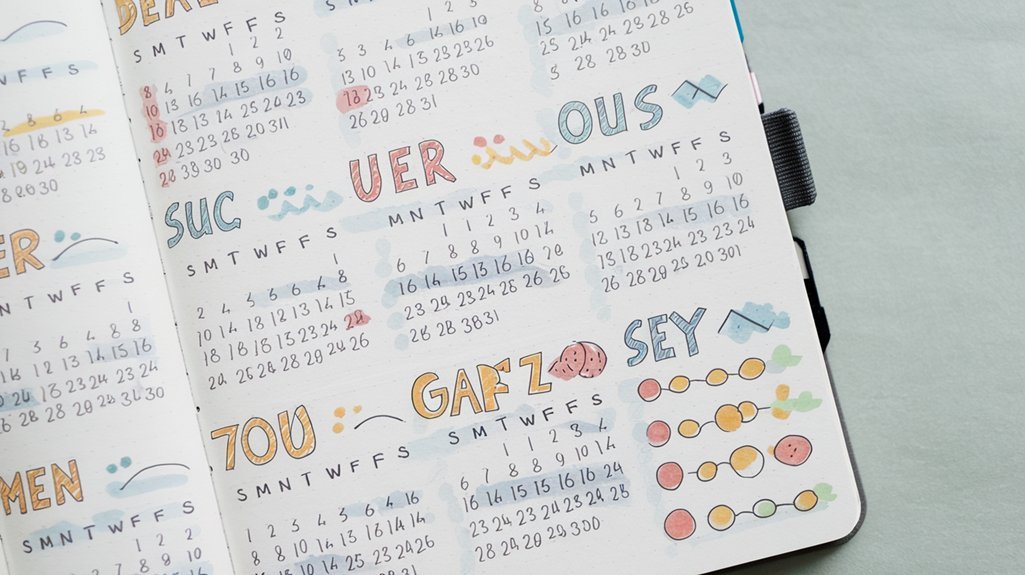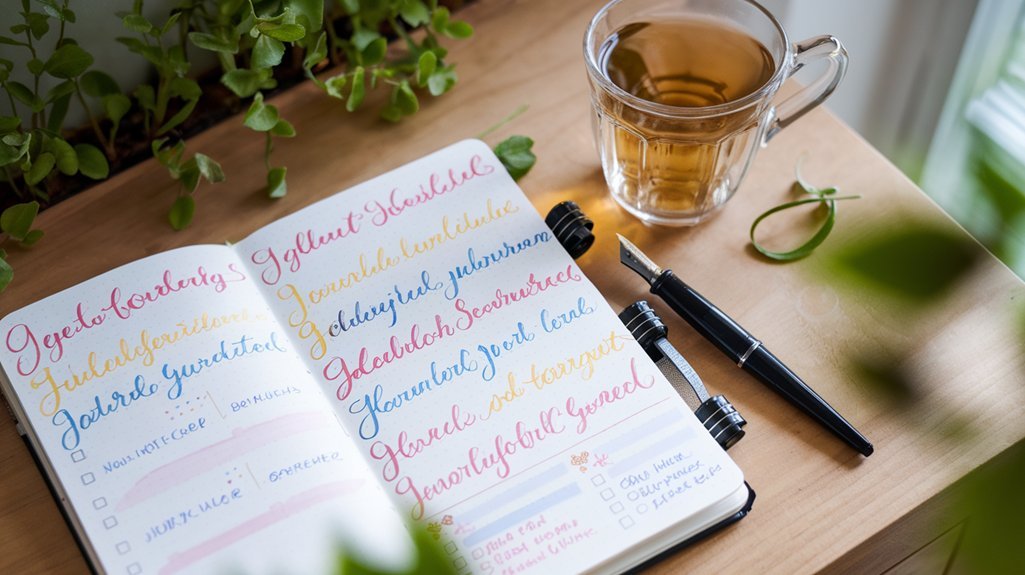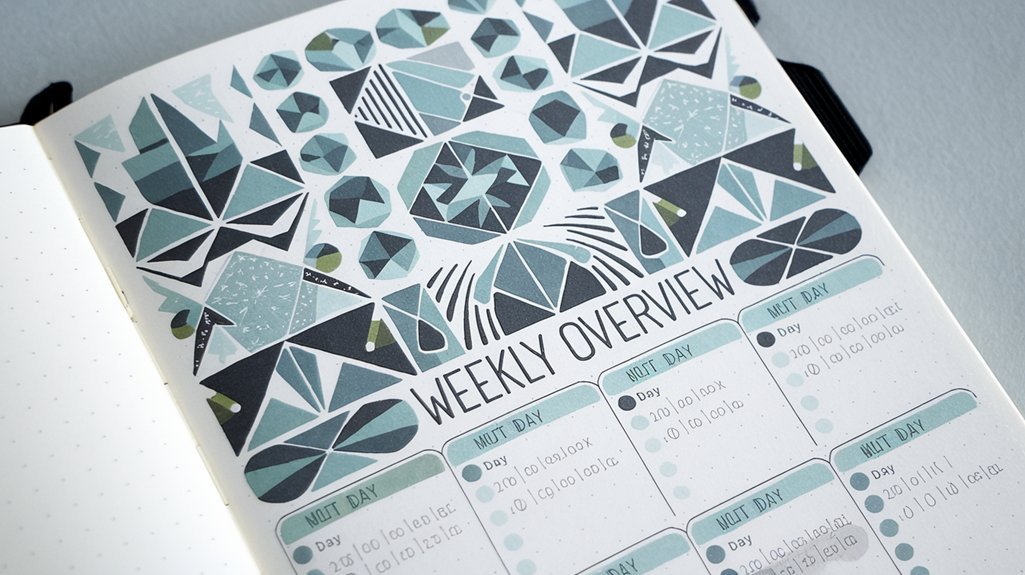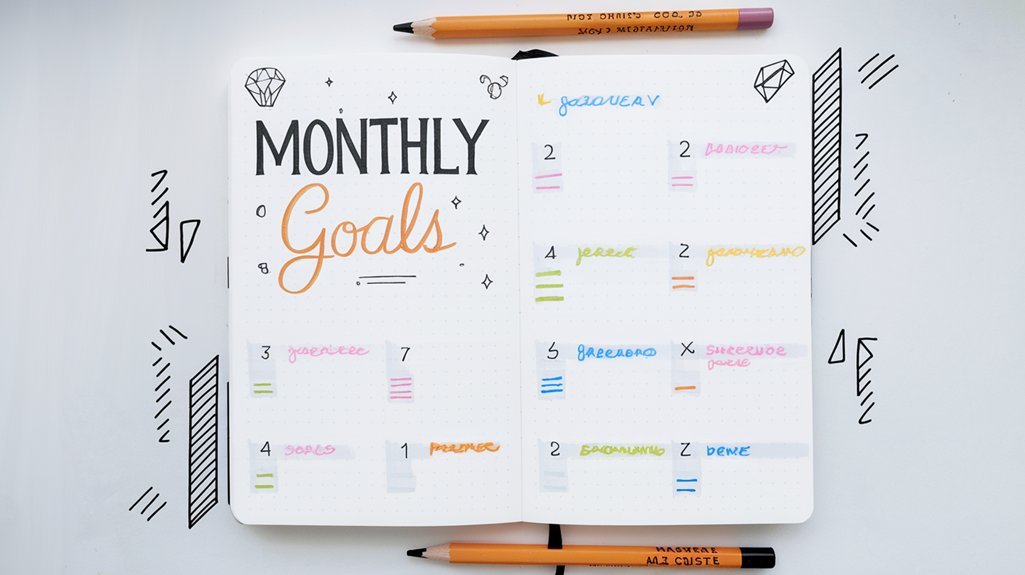Future log layouts in bullet journals range from traditional six-month spreads to innovative designs like the Alastair Method and Dutch Door system. The most effective layouts incorporate clear coding systems, dedicated spaces for events and tasks, and flexible migration options. Popular formats include calendar grids, minimalist rolling quarters, and timeline-based annual plans. Each design serves different planning needs and organizational styles. Understanding these versatile options helps journalers select the ideal layout for their productivity goals.
Traditional 6-Month Future Log Layout
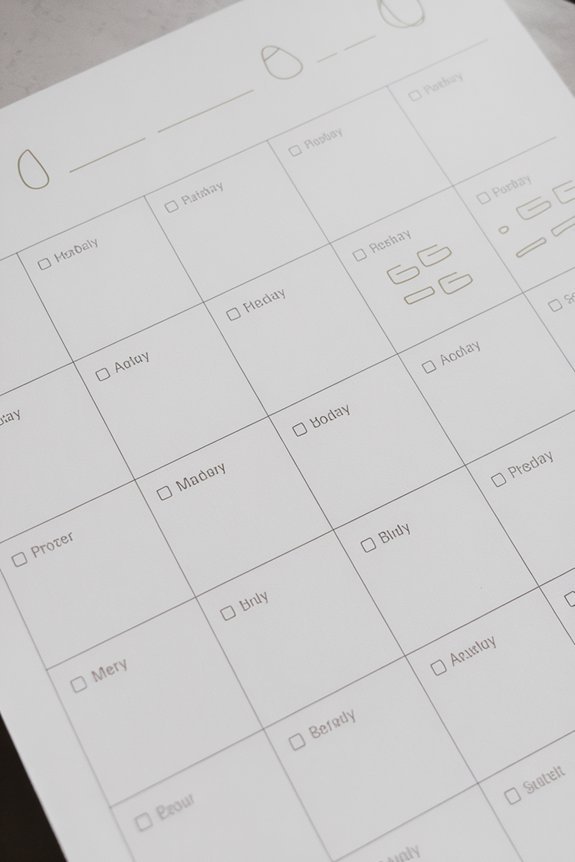
When starting a bullet journal, the traditional 6-month future log layout serves as a foundational planning structure. This layout divides two pages into six equal sections, with each section representing one month. The simple division allows users to maintain minimalist weekly spreads while capturing important future events and deadlines.
The traditional layout's strength lies in its efficient module planning approach. Each monthly section provides adequate space for recording appointments, birthdays, holidays, and long-term tasks. Users can implement a clear coding system, using different symbols or colors to distinguish between various types of entries. The layout also accommodates both time-specific events and floating tasks that need to be addressed within a particular month.
This straightforward design enables quick reference and easy migration of tasks between months, making it particularly effective for individuals who prefer systematic organization without excessive embellishment or complexity.
Alastair Method: A Vertical Planning Approach
The Alastair Method revolutionizes future logging by utilizing a vertical column format that maximizes space efficiency. This innovative layout features dates listed along the left margin, with monthly columns extending across the page. Events and tasks are marked with dots or symbols in the corresponding month's column, creating a clear visual timeline of upcoming commitments.
The method's vertical structure naturally complements vertical habit tracking systems and seamlessly integrates with weekly spread integration. Users can quickly scan across columns to identify scheduling conflicts or patterns in their commitments. Each entry requires minimal space, allowing for extensive future planning within a compact area.
Key benefits include the ability to add months as needed, flexible symbol customization for different types of events, and easy migration of tasks between months. The clean, minimalist design reduces visual clutter while maintaining detailed organization, making it particularly effective for individuals managing multiple projects or long-term planning horizons.
Calendar Grid Style Future Log

Unlike the vertical orientation of the Alastair Method, a Calendar Grid Style Future Log adopts a traditional monthly calendar format within the bullet journal system. This layout presents each month in a familiar grid pattern, allowing users to visualize time blocks and scheduled events more intuitively.
Calendar grid variations can range from minimal to elaborate designs, with users choosing between full-month spreads or condensed mini-calendars. The layout typically includes seven columns for weekdays and encompasses five rows for weeks, creating a structured framework for long-term planning. Custom grid adaptations enable journalers to incorporate additional elements such as habit trackers, mood indicators, or important deadlines alongside the calendar format.
This method proves particularly effective for visual planners who prefer seeing their months laid out in a conventional calendar view, making it easier to identify patterns, schedule conflicts, and available time slots at a glance.
Dutch Door Future Log Design
The Dutch Door Future Log layout creates a distinctive split-page design by cutting horizontal sections of pages to reveal calendar spreads underneath. This innovative setup enables quick access to monthly highlights while maintaining a thorough yearly view through strategically separated page segments. The vertical arrangement maximizes usable space by creating multiple viewing levels, allowing bullet journalists to incorporate more detailed planning elements without sacrificing organization or clarity.
Split Page Setup Instructions
Creating a split-page Dutch Door future log begins with precise preparation of consecutive journal pages. The process requires carefully measured horizontal section dividers across three to four pages, with the middle pages cut shorter to guarantee the full-length back page.
Each trimmed page should be divided into equal modules based on tracking requirements, typically spanning three to six months per visible section. The layout enables simultaneous viewing of multiple months while preserving a clean, organized appearance. The full-length back page serves as an anchor for long-term planning and yearly overviews.
Measurements must be exact to ascertain proper alignment of the module based tracking system. Standard measurements include leaving the top 2-3 inches of each middle page intact while trimming the remaining portions to create the distinctive Dutch Door effect.
Dutch Door Monthly Highlights
While structuring monthly highlights in a Dutch Door format, users can maximize visibility by dedicating specific sections to essential monthly events, deadlines, and milestones. This layout creates an efficient system where monthly spreads remain visible while flipping through daily or weekly pages.
The Dutch Door month end review process becomes streamlined as users can easily reference completed tasks against planned objectives. By cutting horizontal sections in the pages, bullet journalists maintain continuous access to their monthly overview while working with shorter-term planning segments. Dutch door monthly reflections benefit from this design, allowing users to document achievements, challenges, and insights without losing sight of the bigger picture. The layout's versatility accommodates both detailed task tracking and broader monthly goal evaluation, making it an effective tool for extensive future planning.
Maximizing Vertical Space Layout
Building upon traditional Dutch Door designs, vertical space optimization offers bullet journalists an innovative approach to future log layouts. This method maximizes page utilization by creating tall, narrow columns that extend the full length of the journal spread, enabling users to capture more information within a condensed area.
The vertical layout incorporates space saving techniques through strategically placed fold-out panels, allowing seamless integration of monthly overviews alongside detailed future planning sections. Users can implement utilization optimization by dividing the vertical columns into specific categories: appointments, deadlines, and long-term goals. Each section maintains clear visibility while maximizing the available space.
Key features include adjustable column widths, color-coded segments for enhanced organization, and the ability to view multiple months simultaneously without compromising the layout's functionality or aesthetic appeal.
Minimalist Rolling Quarter Layout
The minimalist rolling quarter layout offers a streamlined approach to future planning through a simplified three-month view. Setting up this layout requires only basic horizontal lines to divide months and vertical columns for dates, events, and tasks. The month-at-a-glance format allows users to track upcoming appointments, deadlines, and commitments while maintaining a clean, uncluttered aesthetic that promotes clarity and focus.
Simple Setup Steps
Creating a minimalist rolling quarter layout requires just five minutes and basic supplies: a notebook, ruler, and pen. The setup begins by drawing three horizontal lines across two pages, dividing them into four equal sections. Each section represents one month of the quarter.
The left margin of each section should include space for the month name and dates. The remaining area allows for modular planning of appointments, deadlines, and events. This clean layout supports both monthly overviews and weekly setup adjustments as needed.
Users can enhance the basic structure by adding simple icons, minimal color coding, or small calendars in the corners. The beauty of this system lies in its flexibility and ease of maintenance, enabling quick updates while maintaining a clutter-free view of upcoming months.
Month-At-A-Glance Planning
Once established, a minimalist rolling quarter layout enables efficient month-at-a-glance planning through strategic placement of key information. The format dedicates a single spread to display three consecutive months, rotating forward as each month concludes. Each month occupies one-third of the spread, featuring dates along the left margin and event spaces on the right.
The layout incorporates a weekly overview section at the bottom of each monthly column, allowing users to plan recurring commitments and deadlines. A slim habit tracking bar can be integrated alongside date numbers, maximizing space utility while maintaining the minimalist aesthetic. This streamlined approach eliminates visual clutter and focuses on essential planning elements, making it ideal for busy professionals who need quick access to upcoming appointments and deadlines without excessive detail.
Timeline-Based Annual Planning System

While traditional future logs offer a basic framework for planning, timeline-based annual planning systems provide a more detailed, expansive, or extensive approach to visualizing an entire year's activities and commitments. This system utilizes a linear chronological format, enabling users to plot events, deadlines, and milestones along a continuous timeline that spans twelve months.
The timeline structure incorporates a rolling monthly overview, allowing planners to maintain perspective on both immediate and long-term objectives. Users can segment the timeline into quarters, implementing quarterly tracking metrics to measure progress toward annual goals. The system's visual nature makes it particularly effective for identifying scheduling conflicts, gaps, and periods of high activity.
Key components typically include color-coding for different categories of events, vertical sections for concurrent activities, and clear demarcation of important dates. This layout proves especially valuable for project managers, students with academic calendars, and professionals managing multiple deadlines throughout the year.
Monthly Boxes With Task Migration
Monthly boxes offer a structured alternative to timeline-based layouts, incorporating dedicated spaces for each month alongside a systematic approach to task relocation. This system divides the future log into twelve distinct sections, with each box containing essential monthly deadlines, events, and ongoing projects.
The method excels in weekly task management by providing clear visual boundaries between months, making it easier to transfer incomplete tasks forward. Users can efficiently review and redistribute workload by scanning each box's contents and moving items that weren't completed to subsequent months using a simple arrow notation system.
For long term goal tracking, monthly boxes enable users to break down annual objectives into smaller, monthly milestones. Each box can include a designated area for progress indicators, helping maintain momentum toward yearly targets while preventing important tasks from falling through the cracks. This systematic approach facilitates regular evaluation of goals and seamless task migration across months.
Custom Column Future Log Format
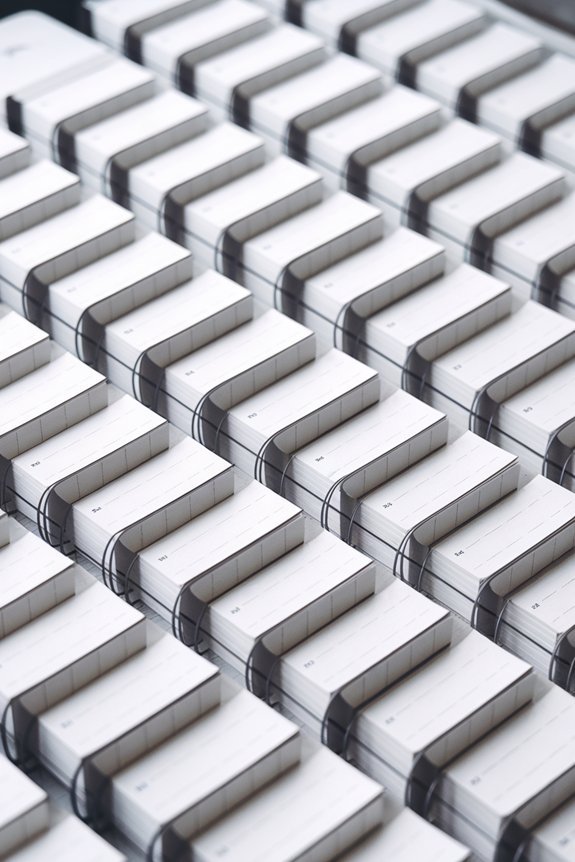
Building upon the structured approach of monthly boxes, custom column formats offer enhanced flexibility for bullet journal enthusiasts who prefer vertical organization. The customized column format allows users to create dedicated spaces for different categories of future planning, such as work deadlines, personal goals, and recurring events.
Users can implement a personalized grid design by dividing their pages into vertical sections, with each column representing specific planning elements. Common configurations include three to four columns per spread, though some practitioners opt for wider layouts across multiple pages. Essential components typically include date indicators, event descriptions, and priority markers.
This format proves particularly effective for individuals who manage multiple projects or roles simultaneously. The vertical alignment facilitates quick scanning of specific categories, while the structured layout maintains clear separation between different types of commitments. Color coding and symbols can further enhance the organization system within each column.
Conclusion
Bullet journal future log layouts serve as essential roadmaps for organized planning, much like how ancient mariners once relied on their sextants to navigate vast oceans. The eight distinct methods presented here offer systematically tested approaches for different planning styles and needs. Whether implementing the Alastair Method's vertical efficiency or the Dutch Door's functional design, users can confidently select and adapt these layouts for ideal productivity and time management success.


